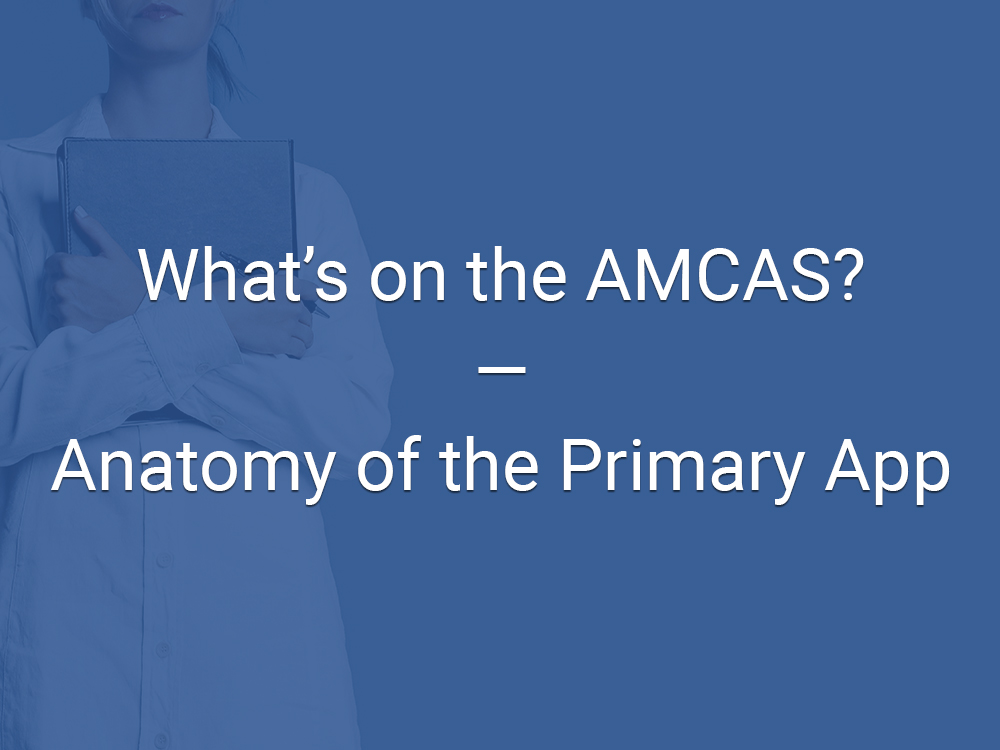
After years of late nights finishing homework, hundreds of hours spent volunteering/shadowing, and numerous extracurricular activities, you’re finally approaching one of the biggest milestones in your budding medical career: your first day of medical school. But, before you pose in your first-day-of-school outfit, you still need to clear two hurdles. One is the MCAT—without a strong MCAT score, getting into one of the top medical schools becomes a bit more difficult, making MCAT prep one of the keys to your success. The other is the medical school application. If you’re going the M.D. route, the main application you need to complete is the American Medical College Application Service® (AMCAS). However, due to the various steps in the medical school application process, there are a ton of questions surrounding what the AMCAS is, what’s on it, and when you need to submit it.
Medical School Admissions Overview
Before we dive into the AMCAS, let’s take a quick look at the timeline of the admissions process. The AMCAS—also referred to as the Primary Application—opens in early May; this is when you can log in to your AAMC account and begin filling out the application. However, you can’t submit until the end of May/early June (the exact date varies every year). Once you’ve submitted the primary application, it needs to be verified by the AAMC (i.e. they need to make sure you weren’t lying about having graduated and whatnot. No catfishing allowed here.) within six weeks. Once it’s verified, the AAMC will send your information to the medical schools you’re applying to. From there, the schools decide if they send you secondary applications, then an interview invitation, and finally an admissions decision. This whole process can wrap up in a few months, though most people will need to practice patience as they wait to see if they move onto the next stage.
Section One of the AMCAS: Identifying Information
You will first provide the AAMC with your name, birth date, sex, and any ID numbers that may appear on transcripts you’ll be including in your application. This is an easy, straightforward section.
Section Two of the AMCAS: Schools Attended
You need to provide information on the schools you’ve attended, including high school and all the postsecondary schools where you were registered for at least one course, even if you didn’t receive credits or you withdrew, as well as any academic or conduct violation you might have incurred at these schools.
You will also need to request a transcript for each of these schools. To make it easier to keep all your materials together, AMCAS provides a Pre-Barcoded Transcript Request Form to send to the registrars of your past institutions. You might want to request a personal copy of each transcript to help you fill out the other parts of the primary application. In addition, it’s your responsibility to ensure the information on your transcripts is accurate and that they are received. Your application will not be processed without an official transcript from every college you’ve listed or a letter confirming no transcript is available.
How do you send transcripts to AMCAS? Most schools will need to send paper versions through the mail. AMCAS only accepts PDF eTranscripts from approved senders. Just remember, official transcripts must come directly from the schools; you cannot submit for them.
Section Three: Biographic Information
The third section of the AMCAS allows you to enter the rest of your basic information such as contact info, alternate contacts, citizenship, ethnicity, languages, family, financial status, and criminal record (if applicable).
Section Four of the AMCAS: Coursework
Remember when we said you should get a personal copy of your official transcripts? This is why. You need to list all the coursework you’ve ever taken at a postsecondary school in chronological order. You also need to include grades received and course descriptions. Although you will provide a GPA from your schools, the AAMC actually calculates its own AMCAS GPA. The BCPM GPA is comprised of Biology, Chemistry, Physics, and Mathematics courses. The remaining coursework will be calculated in the AO (All Other) GPA.
Take as much time as you need to complete this section—incorrect or incomplete information may affect your AMCAS GPA and could delay your application.
Section Five of the AMCAS: Work and Activities
You no doubt have a lengthy resume of activities. This section of the AMCAS is where you choose your top 15 activities to highlight, including work experience, extracurriculars, leadership positions, volunteering, clinical experience, awards, honors, or publications that you would like to bring to the attention of the admissions committees. Try not to add any filler; medical schools are interested in quality, not quantity. You’ll also need to note the number of hours dedicated to each entry and a contact person/supervisor that can be contacted to verify your participation.
From your list of activities, you will then choose up to three “most meaningful experiences” to go into greater detail. Explain what those activities meant to you, what your impact was, and how it contributed to your personal growth.
Section 6 of the AMCAS: Letters of Evaluation/Recommendation (LOR)
A big requirement of medical school admissions is letters of recommendation. The sixth section of the AMCAS is where you can list who will be sending your letters. Your recommender should agree to write a letter for you before you include them on the AMCAS. Most medical schools allow the AMCAS to gather the letters and send them along with your application through the AMCAS Letter Service or Interfolio. However, letters are not required to submit or verify your application. You can submit your application before your LORs arrive at AMCAS and they will distribute them to schools on a rolling basis.
There are three different types of letters you can submit:
- -Committee Letter: A letter from a pre-health committee or prehealth advisor intended to represent your school’s evaluation of you
- -Letter Packet: A packet or set of letters assembled and distributed by your school but does not include an evaluation/recommendation from your prehealth committee or advisor
- -Individual Letter: A letter written by, and representing, a single author
You can choose which schools will receive each letter type. The number or types of letters required vary from school to school; always double-check with the institution you’re applying to. If your recommender is unsure of what to write about, you can always give him some tips from the AAMC, or you can create a quick fact sheet of yourself to help ease their writer’s block.
Section 7 of the AMCAS: Medical Schools
Once you’ve made your list of the medical schools and programs you want to apply to, input them in this section of the AMCAS. You can always add additional schools after submitting your primary application through AMCAS
Section 8 of the AMCAS: Essays
The AMCAS requires you to write a Personal Comments Essay, known more commonly as a personal statement. This is generally when you talk about your “why,” the thing that drove you to start this journey, in 5300 or fewer characters. Everyone has a story and this is the space to share it.
Section 9 of the AMCAS: Standardized Tests
The last and final part of the AMCAS is your MCAT score. All unvoided MCAT sittings and scores will automatically be released to AMCAS. If you haven’t taken the MCAT, plan to retake it, or are waiting for your scores to come back, you must include the date of your recent and/or future MCAT. You can submit the AMCAS and get it verified before you receive your MCAT score but you need to update this section as soon as you can. Luckily, you don’t have to suffer through an additional verification when you update your scores.
If you’re applying to a special program, such as an MD-PhD or an MBA-MD program, this is also where you can submit information from other required tests, such as an LSAT, GMAT, GRE etc.
And now, you’re done! These are all nine sections of the AMCAS. Fortunately, you can begin gathering the information for many of these sections prior to the application opening. Once the application opens, you can work on it and come back as needed before you submit.
Post-Submission Changes
While it’s true most of your application cannot be changed after you submit it, there is information you can update:
- -ID numbers
- -Name, including Legal Name, Preferred Name, and Alternate Names.
- -Contact Information, including Permanent and Mailing Addresses and an Alternate Contact
- -DOB and Sex
- -Letters of Evaluation (addition of no more than 10 letters or notification to AMCAS of a letter that will no longer be sent)
- -Next MCAT test date/updated score
- -Addition of medical schools and change(s) to program type
- -Release of application information to your pre-health advisor
If you disagree with changes made to your Course Work during the AMCAS verification process, you may submit an Academic Change Request for review, though it’s not guaranteed to be approved.
The medical school application process is undoubtedly difficult to navigate. The surplus of information you need to find plus numerous dates and deadlines can easily overwhelm even the most organized among us. You don’t have to go through it alone. Our Medical School Admissions Consultants provide the support and guidance all pre-meds need during this critical stage. Our consultants are former admissions committee members and have years of experience helping students navigate this confusing maze. Schedule a free consultation with our Advisors today to learn how we can help you with your primary application and beyond!
Search the Blog

Free Consultation
Interested in our Online MCAT Course, One-on-One MCAT Tutoring or Med admissions packages? Set up a free consultation with one of our experienced Senior Student Advisors.
Schedule NowPopular Posts
-
MCAT Blog What's on the MCAT?
-
MCAT Blog How to Review MCAT Full Lengths

Free MCAT Practice Account
Need great MCAT practice?Get the most representative MCAT practice possible when you sign up for our free MCAT Account, which includes a half-length diagnostic exam and one of our full-length MCAT practice exams.
Learn More







